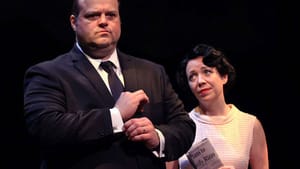Stay in the Loop
BSR publishes on a weekly schedule, with an email newsletter every Wednesday and Thursday morning. There’s no paywall, and subscribing is always free.
Sound and fury, signifying . . . what?
Bruce Graham’s ‘Rizzo’ by Theatre Exile (second review)

To paraphrase Erich Segal in Love Story: What can you say about a bull in a china shop that died?
Frank Rizzo was a combative high school/Navy dropout who rose through the ranks of Philadelphia’s police department and into the mayor’s office on the strength of his commanding personality and genuine, if narrow, constabulary talents — that, as well as the hope of many white Philadelphians that a tough-talking cop would keep blacks and hippies under control. Once in City Hall, Rizzo surrounded himself with loyal sycophants who didn’t dare point out that he was in way over his head. As mayor, Rizzo reduced every problem confronting his administration to a personal battle between himself and some designated foe. (When Rizzo couldn’t find people to attack, he charged against the nearest available inanimate object, like a lie detector or the City Charter.)
His two terms in the 1970s were characterized above all by his seemingly insatiable appetite for combat and attention. In 1978, after suffering overwhelming defeat in his disruptive effort to change the City Charter so he could seek a third consecutive term, Rizzo told a TV interviewer that he had been warned all along that the campaign was doomed, yet he had plunged ahead anyway: “I had to go on that kamikaze mission, or I wouldn’t be Frank Rizzo,” he explained.
Physical intimidation
When he left office in 1980, Rizzo bequeathed to his city a decaying transit system, a politicized school board, spiraling property taxes, reduced city services, racial animosity, 100,000 lost industrial jobs, an annual homicide rate that was 65 percent higher than when he became police commissioner in 1967, and nearly 250,000 lost population. Yet instead of departing “graciously,” as he once promised, he ran for mayor again and again and again for the rest of his life, relenting only when the Great Election Judge In the Sky finally put the kibosh on his delusions in the middle of the 1991 campaign.
Bruce Graham’s Rizzo, a two-act play currently receiving its world premiere production commissioned by Theatre Exile, effectively conveys some sense of the hostility, negativity, and downright nastiness that pervaded Philadelphia during the Age of Rizzo, a period of some two dozen years when thousands of Philadelphians were forced to focus their civic energies on Rizzo (either to elect him, or to prevent his election). Although the gargantuan Scott Greer in the title role reminded me more of Jackie Gleason than Frank Rizzo, he does convincingly demonstrate how Rizzo used his bullying physicality to intimidate just about everyone he met, from schoolmates to street thugs to judges to politicians to a long line of impressionable journalists. Of the six other actors who assume multiple roles, Paul L. Nolan effectively portrays Martin Weinberg, the bland consigliere who hitched his wagon to Rizzo’s more brilliant star much as Karl Rove later orchestrated the rise of George W. Bush from behind the scenes.
Talking heads
There’s a good civics lesson in Rizzo, for sure — and a timely one, too, coming as it does in a year when millions of Americans seem to have gone belly-up for demagogues like Donald Trump and Ben Carson, whose qualifications for public office are even slimmer than Rizzo’s. But is there a play here? Is the Frank Rizzo story a romance, a tragedy, a comedy, a farce, or (more likely) none of the above?
In Greek tragedy, the protagonist marries his mother and/or gouges his eyes out. In Shakespeare, political rivals are murdered and kingdoms are overthrown. But in Rizzo, the blacks protest, the liberals circulate petitions, the peasants move to Jersey, and ol’ man Rizzo, he jus’ keeps runnin’ for office. It’s not exactly a compelling dramatic arc, you know what I mean?
Rizzo suffers as well from the limitations of its source. Graham appears have drawn his material entirely from S.A. Paolantonio’s 1993 biography, Frank Rizzo: The Last Big Man in Big City America. As its artless and pointless title suggests, Paolantonio’s hyperbolic book is a breathless compendium of surface minutiae — headlines, public announcements, press conferences, and talking heads — but no evidence that Paolantonio ever asked himself, “Why am I writing this book?”
Rivals celebrate
The only aspect of Rizzo’s life that merits a book — or a play — is his astonishing rise from South Philadelphia rowhouse to mayor of America’s fourth-largest city. But the excitement or shock (depending on your viewpoint) of that ascent was lost on Paolantonio, who didn’t arrive in Philadelphia until 1985 (five years after Rizzo left office); consequently, he perceived Rizzo’s rise as a foregone conclusion.
To his credit, Graham, facile playwright that he is, ignored the trivia from Paolantonio’s book and focused on the juicy parts. But he overlooked some of the best dramatic episodes that escaped Paolantonio’s notice altogether. For example:
- During a private meeting with his business advisory board in 1973, Rizzo responded to mild criticism from banker John Bunting by asking the city’s finance director, “How much money do we have in that prick’s bank?” and then barking, “Take it out! Take it all out!”
- When Philadelphia’s Democratic City Committee refused to seat him on the dais for the party’s annual dinner in 1974, Rizzo led 150 union supporters into the hall for a prearranged demonstration characterized by fistfights, broken dishes, and overturned tables.
- After he suffered overwhelming defeat in his 1978 effort to change the City Charter so he could seek a third term, Rizzo’s rivals — mistakenly thinking they’d seen the last of him — celebrated by singing, “Ding Dong, the Witch Is Dead!”
Beneath the surface
Episodes like these might have injected some genuine drama into Rizzo. But Graham had to work within the confines of a seven-person cast and a largely empty stage with just a handful of props (a chair, a podium) and screen projections of video clips and headlines (used to good effect, to be sure). So Rizzo’s cast is saddled with an excess of expository dialogue, much of it recited to journalists armed with note pads and microphones — a tired device for informing the yokels in the audience.
Political theater need not be two-dimensional. The 1959 Broadway musical Fiorello!, Jerome Lawrence and Robert E. Lee’s 1959 play The Gang’s All Here (about the Harding administration), and Gore Vidal’s 1960 play Best Man all dug deeply within the interiors of complex public figures. The problem with Rizzo, ironically, lies in its subject. As I discovered through years of jousting with Rizzo — and as Graham himself has acknowledged — when you scratch the surface of this seemingly larger-than-life figure, you find there isn’t much there. The real story of those years is not Rizzo but the supporters who swallowed his Kool-Aid, as well as the odd alliance of liberals, blacks, Hispanics, homosexuals, and, yes, even Anglo-Saxon Protestants who formed a coalition to fight Rizzo that has more or less persisted to this day, when energies that once were drained in the fight against Rizzo can now be channeled in more productive directions.
Graham, who traces his own roots to Rizzo’s South Philadelphia neighborhood, has carved something of a niche for himself as the unofficial voice of Philadelphia’s white rowhouse working class — that is, Rizzo’s constituency. It took some courage for Graham to challenge the divinity of his audience’s patron saint, as he has done in Rizzo. Of course, it would have been far more courageous — and more dramatic, too — had Rizzo been produced when its belligerent protagonist was still alive.
To read a review by Carol Rocamora, click here; to read a review by SaraKay Smullens, click here.
What, When, Where
Rizzo. By Bruce Graham, from the book by S.A. Paolantonio; Joe Canuso directed. Theatre Exile production through November 8, 2015 at Christ Church Neighborhood House, 20 N. American Street (between Second and Third), Philadelphia. 215-218-4022 or theatreexile.org.
Sign up for our newsletter
All of the week's new articles, all in one place. Sign up for the free weekly BSR newsletters, and don't miss a conversation.

 Dan Rottenberg
Dan Rottenberg